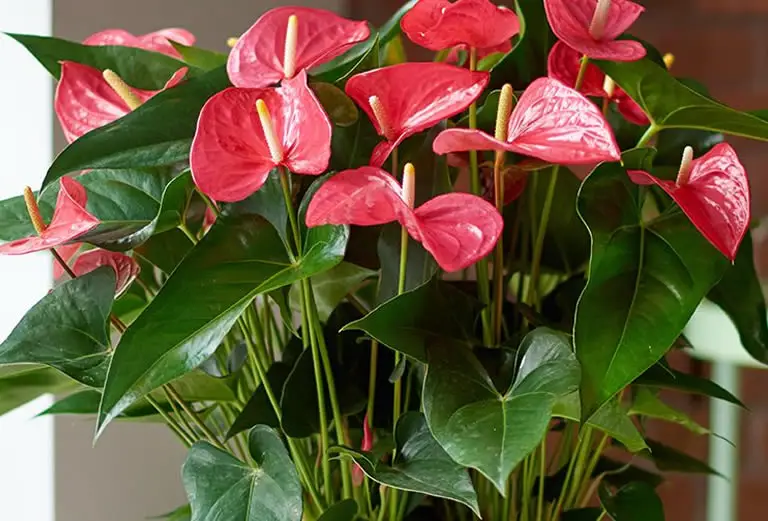Anthuriums are prized for their stunning, colorful bracts that come in bold shades like red, pink, and white, and they often bloom throughout the year. So, it can be disappointing when your Anthurium seems healthy but doesn’t produce any flowers.
Table of Contents
- Why Isn’t My Anthurium Flowering?
- 7 Tips to Help Your Anthurium Bloom
- Is Your Anthurium Planted in the Right Potting Mixture?
- Incorrect Lighting: The Most Common Cause of an Anthurium Not Flowering
- Temperature Issues That Could Be Preventing Your Anthurium From Flowering
- Anthuriums and Humidity
- Proper Watering to Encourage Anthurium Flowering
- The Secret Fertilization Method for Anthurium Blooms
- Does Your Anthurium Need Repotting to Help It Bloom?
Why Isn’t My Anthurium Flowering?
If your Anthurium isn’t flowering, there could be a number of reasons behind it. These plants are a bit picky when it comes to their environment, so things like overwatering, poor light, or even low humidity can stop them from blooming.
However, with the right care, you can encourage your Anthurium to flower.
Provide bright indirect sunlight, ensure the soil isn’t too soggy, keep humidity levels high, and feed your plant weekly with a diluted, phosphorus-rich fertilizer to give it a boost.
In this post, we’ll explore the common issues that could be preventing your Anthurium from flowering and share practical tips to help you get those beautiful blooms!
Anthurium Houseplant Care: The Basics for Healthy Blooms
If you want your Anthurium to bloom beautifully, providing the right growing environment is key.
These plants are native to tropical rainforests, and most houseplant varieties are epiphytic, meaning they grow on trees like orchids and bromeliads.
They can be a bit particular about their care, but don’t worry — once you understand their needs, they’re easy to grow and care for!
Anthurium Houseplant Care Quick Summary
To get your Anthurium to produce those stunning blooms, make sure you’ve got the right spot in your home and are meeting all its care requirements.
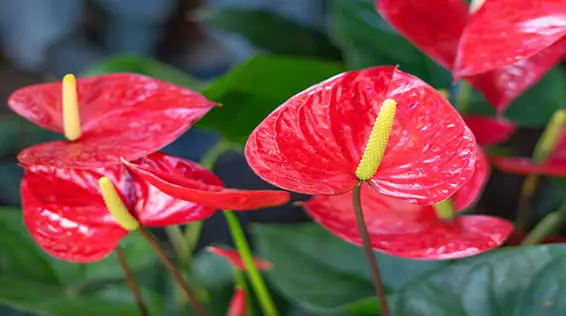
Here’s a quick guide to help you get started:
- Potting Mix: Choose a well-draining peat-based or pine bark potting mix.
- Light: Place your Anthurium in a spot with bright, indirect sunlight all day.
- Temperature: Ideal range is 70-85 °F (21-29 °C).
- Humidity: Keep humidity levels high for your Anthurium’s health.
- Watering: Allow the potting mix to dry out slightly between waterings.
- Fertilizing: Feed with a high-phosphorus liquid fertilizer weekly, diluted to 10-20% strength.
- Repotting: Repot your Anthurium every two years.
For a more in-depth look at our Anthurium care article, check out my full guide here.
7 Tips to Help Your Anthurium Bloom
In the upcoming sections, we’ll dive deeper into each of these care elements and troubleshoot common issues that could be stopping your Anthurium from blooming.
Is Your Anthurium Planted in the Right Potting Mixture?
If your Anthurium isn’t blooming, the potting mixture might be the culprit.
Anthuriums are very particular about their soil, and if it’s not draining well, the plant could be facing issues.
Waterlogged soil doesn’t allow the roots to absorb enough oxygen, which weakens the plant and leaves it unable to gather the energy needed for blooming.
Plus, when the soil doesn’t drain properly, it can lead to root rot.
In their natural habitat, Anthuriums grow on trees in tropical rainforests. This is one reason why orchid soil mixes work so well for cultivating Anthurium.
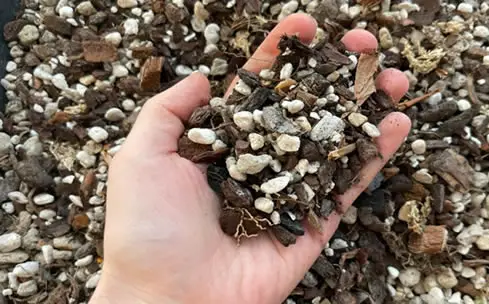
While they do get plenty of rain, their roots are exposed to the air, not buried in soggy soil.
Their roots are adapted to cycles of rainfall and drying, and they do not tolerate waterlogged conditions.
To ensure your Anthurium thrives and continues to bloom, use a potting mixture that drains well.
You can opt for an orchid potting mix or create your own by combining peat, pine bark, and materials like perlite or volcanic rock for excellent aeration.
And don’t forget: your plant’s container should always have drainage holes to allow excess water to escape!
Incorrect Lighting: The Most Common Cause of an Anthurium Not Flowering
If your Anthurium isn’t blooming, one of the top reasons might be insufficient light.
While Anthuriums can thrive and produce plenty of healthy foliage in lower light conditions, they won’t flower without plenty of bright, indirect sunlight.
Ideally, your plant should be placed in an area where it gets bright but diffused light all day, rather than just for a few hours.
Don’t have a spot in your home or office that gets enough light? No worries! You can use a full-spectrum grow light to make sure your Anthurium gets about 9 hours of optimal light each day.
With the right lighting, you’ll soon enjoy the stunning blooms that make these plants such a special addition to your space.
Temperature Issues That Could Be Preventing Your Anthurium From Flowering
Anthuriums thrive best in temperatures between 70-85 °F (21-29 °C), making them ideal for most indoor settings.
However, these plants are sensitive to sudden temperature shifts.
If your Anthurium is near a drafty window, an external door, or close to heating and cooling vents, it may not be getting the steady conditions it needs to bloom.
Anthuriums don’t like rapid temperature changes or direct exposure to drafts, like from an air conditioning vent or exhaust fan.
To encourage blooming, you may just need to move your plant to a spot away from these temperature fluctuations.
Anthuriums and Humidity
Being tropical plants, Anthuriums need high humidity to stay healthy and flower.
If the air around your plant is too dry, the leaves may lose their sheen and the plant may struggle to bloom.
To boost the humidity around your Anthurium, you can group your plants together, place a humidifier nearby, or set your plant on a humidity tray—this is simply a shallow tray filled with pebbles and water, making sure the pot doesn’t touch the water.
Just remember that while high humidity is important, you’ll also want some air circulation to prevent mold, fungus, and pests.
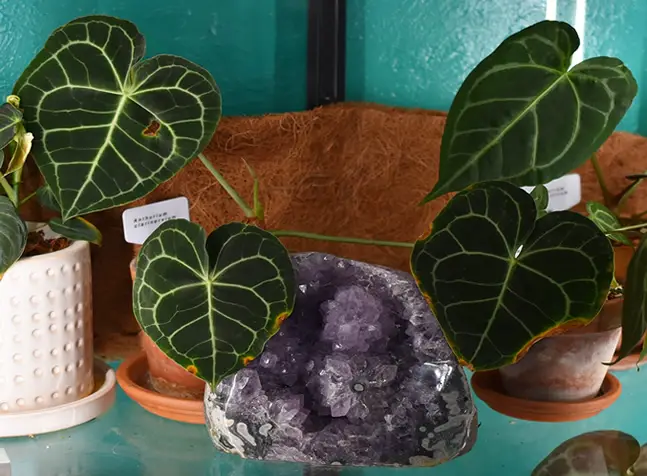
A fan placed nearby (but not blowing directly on your plant) will help keep the air moving and ensure your Anthurium stays healthy and happy.
Using a good quality humidifier is a great way to ensure your plant is getting the correct humidity levels that it needs.
Proper Watering to Encourage Anthurium Flowering
Improper watering is another common reason your anthurium might not be flowering. While it’s true that anthuriums enjoy moisture, they don’t do well in consistently soggy soil.
Their roots are used to being exposed to air in their natural environment, so too much water can lead to root rot and hinder the plant’s ability to bloom.
However, underwatering can also be harmful, preventing the plant from thriving.
So, what’s the right watering routine for your anthurium?
Water the potting mix thoroughly, making sure that excess water drains out of the pot.
Then, check the moisture level by sticking your finger or a wooden stick into the soil.
Only water again when the soil feels slightly dry, but not completely dry.
You don’t want the soil to stay bone dry for too long, but you also don’t want it soggy.
How often should you water your anthurium? It depends on several factors, like local climate, time of year, and the size of your plant.
For instance, during hot summer months, you may need to water more frequently, while cooler seasons will require less frequent watering—usually around once a week.
Just keep an eye on the soil moisture, and your anthurium will thank you with beautiful blooms!
Be aware that improper watering can lead to yellow leaves on an anthurium and/or can make anthurium leaves turn brown.
The Secret Fertilization Method for Anthurium Blooms
In their natural environment, epiphytic anthuriums get a steady supply of nutrients through rainwater, decayed plants, and forest debris.
To mimic this in your home and encourage your anthurium to bloom, feed it small amounts of a phosphorous-rich liquid fertilizer once a week.
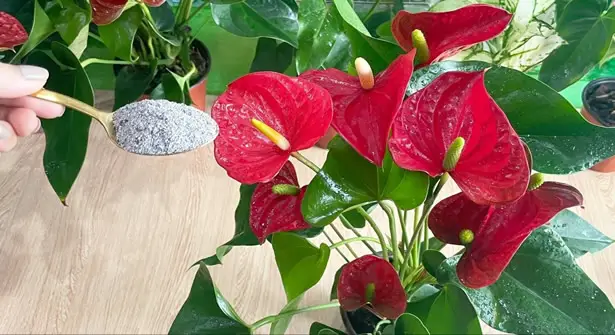
This method, known as the “weakly, weekly” approach, involves diluting the fertilizer to 10-20% strength and adding it to the soil after watering or spraying it on the foliage.
This regular but mild feeding can give your anthurium the nutrient boost it needs to produce beautiful flowers. Using a good quality orchid feed is advisable.
Does Your Anthurium Need Repotting to Help It Bloom?
Repotting your anthurium every two years is a good way to ensure it stays healthy and blooms regularly.
Over time, the potting mix can break down, becoming compacted and depriving the roots of oxygen.
Plus, fertilizer salts can build up, potentially stressing the plant and hindering flower production.
If you notice these issues, it’s time to repot.
When doing so, choose a container that’s just slightly larger than the current one—anthurium roots like being a little pot-bound.
Don’t repot just because the plant’s roots have filled the pot; make sure the soil is in poor condition or the roots are damaged from overwatering.
Repotting also gives you the chance to ensure the right type of potting mix is used—well-draining and light, with enough aeration for healthy root growth.
By maintaining good soil health and avoiding stress, you’ll set your anthurium up for successful blooming!

